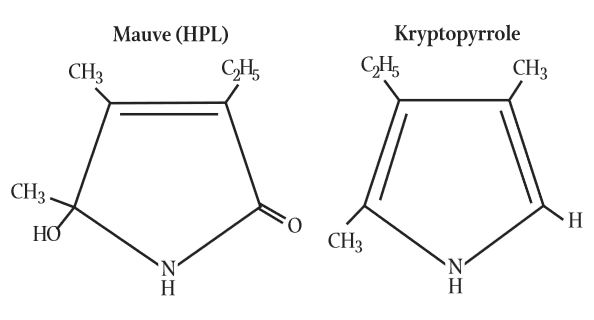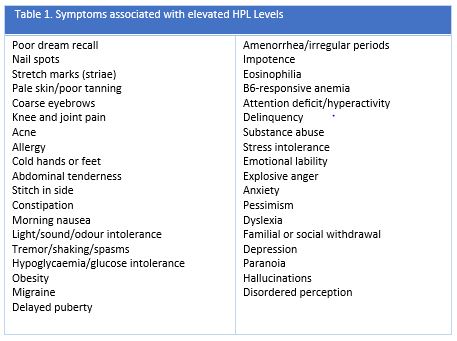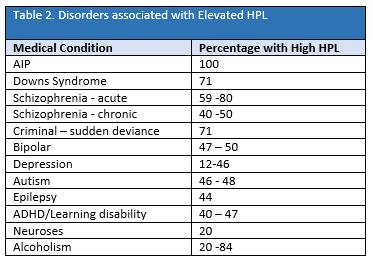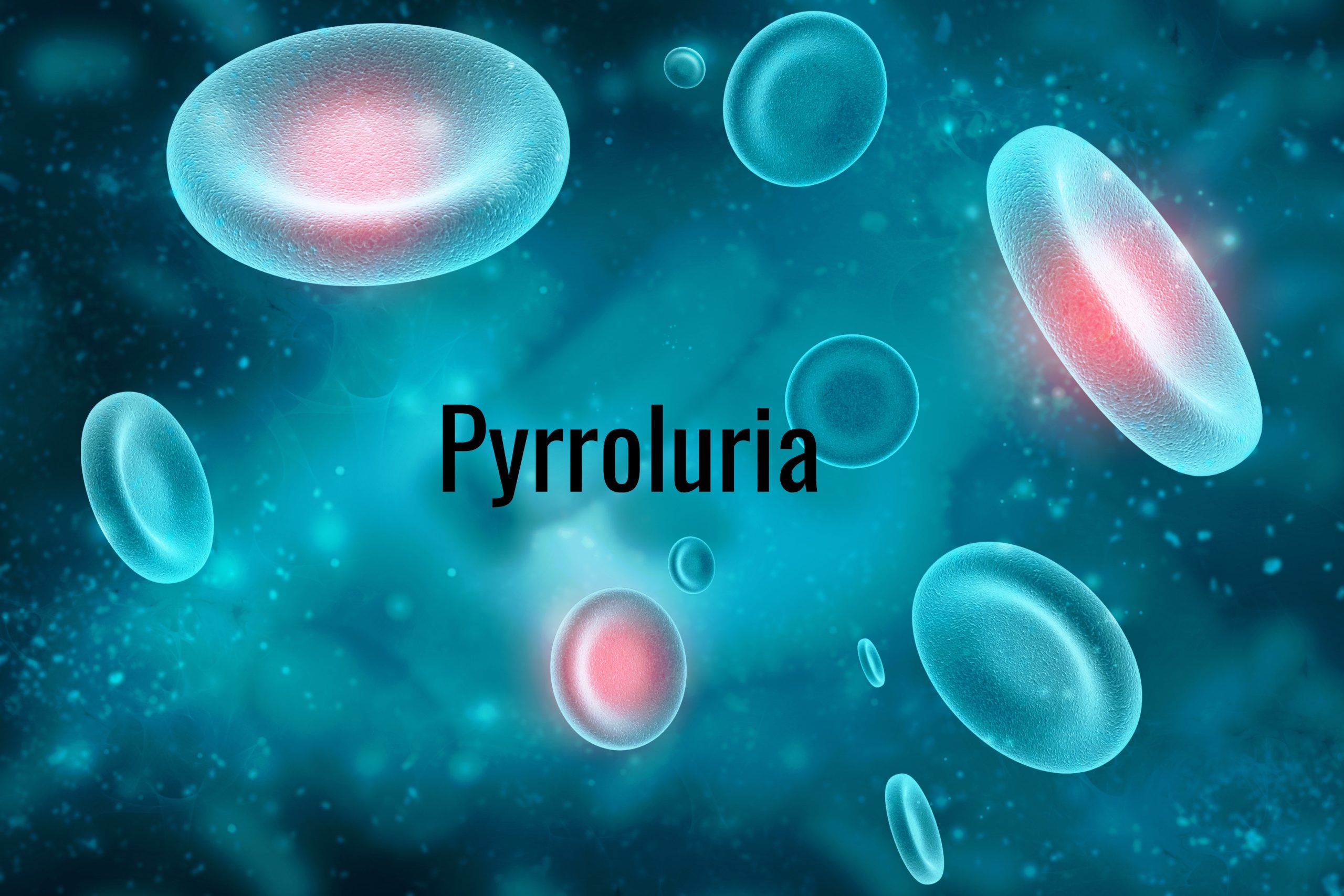Is Pyrroluria a discrete medical condition or is it a biomarker of other pathology? Courtesy of InterClinical Laboratories,we take a look into the history, research findings and treatment options.
Detection
Hydroxyhemopyrrolin-2-one (HPL) or “mauve factor” was first discovered in 1958 in the urine Dr Hoffer’s psychiatric patients. It was named after the colour it appeared in chromatograph assays. It was later identified by a fellow researcher, Irvine, as a member of the pyrrole group. Pyrroles in humans, are a group of 5-carbon aromatic ring compounds that are the byproducts of haem synthesis.
Irvine’s original research incorrectly identified the pyrrole involved as kryptopyrrole, due to the limitations of the technology at that time. Later it was correctly identified as the hydroxylactam of haemopyrrole namely hydroxyhaemopyrrolin-2-one, a bioproduct of haemoglobin metabolism. Figure one below shows the similarities and differences between the two chemical moieties. (1)
Fig 1. Kryptopyrrole Moiety compared to HPL Moiety

Associated Nutritional Deficiencies
Early psychiatric researchers, Pfeiffer and associates, observed that they could resolve pyrrole disorder, also called the “mauve factor”, by administering vitamin B6 and zinc. People suffering from the “mauve factor” would present with a range of psychological and emotional symptoms. Further studies have confirmed that high HPL levels are significantly correlated with low vitamin B6 and zinc levels (< P 0.001). Biotin deficiency may also occur with elevated HPL levels. Initial evidence comes from a small study where 100 % of patients (16/16) with elevated HPL, were found to have below normal levels of biotin. Other potential nutrients affected such as folate, vitamin B12 and niacin failed to show any consistent correlations. (2,3,4,5,6,7,8)
Another possible nutritional deficiency was identified in early mental health research examining fatty acid production and pyrroluria. It pointed to inhibition of delta-6-desaturase activity, possibly due to a pyridoxine dependent cystathionine beta synthase disturbance. (9)
Associated Symptoms
Although the mechanism is unknown, HPL appears to bind with zinc and vitamin B6 making these nutrients somewhat unavailable to the body; with the level of binding and consequent deficiency being proportional to the level of HPL present. Higher levels appear to cause more severe emotional, psychological, cognitive and physical symptoms. Most of the symptoms connected with high levels of HPL reflect deficiencies of the component nutritional deficiencies i.e. zinc, vitamin B6 and possibly biotin. Table 1. shows the typical range of symptoms mentioned in the literature, largely gleaned from clinicians reports, from research and from reviewers data mining laboratory results on a large scale. (2,3)

Adapted from: Discerning the mauve factor, part 1. (2)
Associated Medical Conditions
When a group of medical researchers conducted a review of the literature they found data showing many medical neurobiological conditions are associated with elevated HPL, see Table Two below for details.(2,3)

Adapted from: Discerning the mauve factor, part 1. (2)
BIO-MARKERS
Nutritional Deficiencies
Given the statistically significant nutritional relationship between levels of HPL and vitamin B6 and HPL and zinc deficiency, elevated HPL can be considered a biomarker for both vitamin B6 and zinc deficiency. Empirical confirmation of this is that restorative supplementation has been shown to dramatically reduce a wide range of neurobehavioral symptoms with a high level of consistency. (2,3,4,5,6,7)
Oxidative Stress
The research also points to HPL as a biomarker for oxidative stress. Researchers have found that HPL correlates negatively with plasma reduced glutathione (GSH), the body’s main antioxidant, and with red blood cell catalase which protects the body’s cells from reactive oxygen species. Thus it correlates with low antioxidant status and high oxidative stress.
Other researchers have found a direct correlation with plasma nitric oxide (P<0.0001) levels. Very high levels of nitric oxide can inhibit methionine synthase activity thereby reducing production of the essential amino acid methionine. Yet other studies link HPL to higher levels of the intestinal permeability marker indican (P<.0001). Further evidence suggestive of a gut bacterial overgrowth endotoxicity connection is the finding that antibiotics reportedly reduce HPL in urine. Preclinical studies also show direct neurotoxic effects in animals. (2,3,10).
Causes
Genetic, environmental, psychosocial and nutritional factors have all been postulated as possible/probable causes for the overproduction of HPL, however definitive cause remains unidentified. Perhaps, largely due to the effectiveness of vitamin B6 and zinc at rapidly resolving many symptoms – no pressing need has been seen for large scale research. Without further research however, it is impossible to tell if Pyrroluria is a distinct medical condition or a biomarker. Despite the cause not being well understood it has been clearly shown to be a biomarker of zinc, vitamin B6 nutritional deficiencies and a biomarker of oxidative stress.
INTERCLINICAL COMMENT
These findings imply a need for supplementation of zinc and vitamin B6 where HPL is elevated, with dosage proportional to the level of HPL present. The findings also suggest that steps need to be taken by the clinician to reduce oxidative stress and endotoxicity within the body. Other possible supplementation may include biotin and omega 6 fatty acids, especially evening primrose oil. (8,9)
Hair Tissue Mineral Analysis (HTMA) has proven to be an effective means of testing zinc status within the body. Further to this, HTMA reveals the levels of other important minerals and toxic elements that may be antagonising zinc and vitamin B6 levels in the body. As such, HTMA is often recommended as a very useful health screening tool when treating patients with pyrroles.
For a number of additional minerals and toxic elements that may act antagonistically towards zinc and vitamin B6. Thus, the use of HTMA may be very beneficial when testing and treating patients with pyrroles.
A multi-stage trial is currently being conducted in Australia looking into the merits of pyrrole testing and while we anticipate the results with interest, research into characterisation of the disorder still awaits future research. (11) However, in the mean time, symptomatic relief with zinc and Vitamin B6 has been found to be highly effective.
HTMA – Hair Tissue Mineral Analysis is available at True Medicine where our clinicians are trained in interpretation of the results, treatments and quality supplements.
References
- Irvine DG. Hydroxy-hemopyrrolenone, not kryptopyrrole, in the urine of schizophrenics and porphyrics. Clinical chemistry. 1978 Nov 1;24(11):2069-70.
- McGinnis WR, Audhya T, Walsh WJ, Jackson JA, McLaren-Howard J, Lewis A, Lauda PH, Bibus DM, Jurnak F, Lietha R, Hoffer A. Discerning the mauve factor, part 1. Alternative Therapies in Health and Medicine. 2008;14(2):40-51.
- McGinnis, W.R., et al., Discerning the Mauve factor, Part 2. Alternative Therapies in Health and Medicine, 2008. 14(3): p. 56-62.
- Pfeiffer CC, Sohler A, Jenney EH, et al. Treatment of pyroluric schizophrenia (malvaria) with large doses of pyridoxine and a dietary supplement of zinc. J Appl Nutr. 1974;26:21-28
- Pfeiffer CC, Audette L. Pyroluria-zinc and B6 deficiencies. lnt Clin Nutr Rev. 1988;8:107-109.
- Sohler A, Pfeiffer CC. Vitamin B6 nutritional status of a psychiatric outpatient population. Orthomolec Psychiatr. 1982:ll:81-86
- Almudahka AA. Dream recall, short-term memory and a urine marker for pyrrole disorder-A pilot study. 2018 Griffith University
- Mock DM, Henrich CL, Carnell N, Mock NI. Indicators of marginal biotin deficiency and repletion in humans: validation of 3-hydroxyisovaleric acid excretion and a leucine challenge. The American journal of clinical nutrition. 2002 Nov 1;76(5):1061-8.
- Heleniak EP, Lamola SW. A new prostaglandin disturbance syndrome in schizophrenia: delta-6-pyroluria. Medical hypotheses. 1986;19(4):333-8.
- Mikirova N. Clinical test of pyrroles: usefulness and association with other biochemical markers. Clin Med Rev Case Rep. 2015;2:027.
- Steel A, Rainforest J, Schloss J. Verifying the validity of urinary kryptopyrrole (UKP) testing in an adult population: protocol for a multi-stage research project. Advances in Integrative Medicine. 2019 Feb 16

